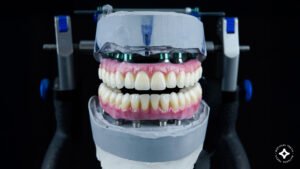For many patients with significant jawbone deterioration, traditional dental implants are not an option. The thought of undergoing bone grafting can be daunting, both in terms of recovery and cost. Fortunately, subperiosteal implants offer a secure, graft-free alternative, providing a stable foundation for dental prosthetics without the need for invasive bone augmentation.
At Natural Teeth Implant Center, we specialize in advanced solutions like subperiosteal implants to help patients regain their smiles with confidence.
But what exactly are subperiosteal implants, and how do they work? Who is an ideal candidate, and what benefits do they offer over traditional implants? In this comprehensive guide, we’ll answer all your questions and explore why this innovative approach may be the best solution for severe bone loss.
What Are Subperiosteal Implants?
Unlike traditional dental implants, which are surgically placed into the jawbone, subperiosteal implants are custom-designed frameworks that sit on top of the jawbone, just beneath the gum tissue. This unique design makes them an excellent option for patients who lack sufficient bone density for conventional implants.
Key Features of Subperiosteal Implants:
-
No bone grafting required – Ideal for patients with severe bone loss.
-
Custom-fitted for stability – Each implant is tailored to the patient’s jaw structure.
-
Faster treatment timeline – Eliminates the need for lengthy bone graft healing.
-
Natural-looking results – Supports prosthetics that function and feel like real teeth.
This approach is particularly beneficial for those who have been told they are not candidates for traditional implants due to advanced bone resorption.
Who Is a Candidate for Subperiosteal Implants?
Subperiosteal implants are designed for patients who:
-
Have severe jawbone loss and cannot support traditional implants.
-
Want to avoid bone grafting due to medical or personal reasons.
-
Need a long-term, stable solution for missing teeth.
-
Seek a faster alternative to multi-stage implant procedures.
A thorough evaluation, including 3D CBCT imaging, helps determine if this solution is right for you.
Benefits of Subperiosteal Implants Over Traditional Implants
-
No Need for Bone Grafting
Bone grafting can add months to the treatment process. Since subperiosteal implants sit on the jawbone rather than inside it, they bypass the need for grafting altogether.
-
Faster Treatment and Recovery
With no graft healing required, the overall treatment timeline is significantly shorter. Many patients receive their final restoration in a matter of weeks.
-
Customized for Maximum Stability
Each implant is precision-crafted to fit the patient’s unique jaw anatomy, ensuring a secure and comfortable fit.
-
Restored Functionality and Aesthetics
Patients can eat, speak, and smile confidently, knowing their prosthetic teeth are firmly supported.
The Subperiosteal Implant Procedure: Step by Step
-
Consultation & 3D Imaging
A CBCT scan provides a detailed view of your jawbone structure, allowing for precise implant design.
-
Custom Implant Fabrication
Using the scan data, a custom metal framework is created to fit your jaw perfectly.
-
Surgical Placement
The implant is placed beneath the gum tissue, resting securely on the jawbone. Sedation options ensure a pain-free experience.
-
Healing & Final Restoration
After a brief healing period, your permanent prosthetic teeth are attached, completing your smile transformation.
Frequently Asked Questions About Subperiosteal Implants
-
How long do subperiosteal implants last?
With proper care, they can last 20+ years, similar to traditional implants.
-
Is the procedure painful?
No—sedation ensures a comfortable experience, and post-op discomfort is manageable.
-
Can subperiosteal implants support dentures?
Yes, they provide a stable base for fixed or removable dentures.
-
What’s the success rate of subperiosteal implants?
Studies show a high success rate (90%+) when placed by experienced surgeons.
-
Are they more expensive than traditional implants?
While costs vary, they may be more affordable when factoring in avoided bone grafts.
-
How soon can I eat normally after surgery?
Most patients resume a soft diet within days and normal eating after healing.
-
Do subperiosteal implants require special care?
Regular brushing, flossing, and dental check-ups are essential.
-
Can smokers get subperiosteal implants?
Smoking increases risks, but some smokers may still qualify after evaluation.
-
What if my jawbone continues to deteriorate?
The implant’s design accommodates bone changes, maintaining stability.
-
Are there any age restrictions for this procedure?
No—candidacy depends on bone health, not age.
Conclusion:
Are Subperiosteal Implants Right for You?
If you’ve been told you don’t have enough bone for traditional implants, subperiosteal implants could be your ideal solution. With no grafting required, a faster recovery, and long-lasting stability, they offer a life-changing alternative for patients with severe bone loss.
At Natural Teeth Implant Center, our experts specialize in advanced implant techniques to restore smiles with confidence.





